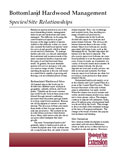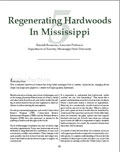Game Animals
Non-game Animals
Habitat
Bottomland Hardwoods
- Found along waterways and drainage areas
- Reduce the risk and severity of flooding downstream
- Support a great variety of trees and shrubs
- Provide habitat for terrestrial and aquatic wildlife
Habitat Description: Backyard Forests
Bottomland hardwood forests are flooded forests occurring along waterways. They are located in the southeast and south central United States, generally in broad floodplains. These ecosystems are commonly found wherever streams or rivers cause flooding beyond their channels. Bottomland hardwood forests can reduce the risk and severity of flooding to downstream communities by providing areas to store floodwater.
Bottomland hardwood forests support a great variety of tree and shrub species. Typical tree species growing in these forests range from cottonwoods and sweetgums to cherrybark oaks, water oaks and hickories. Leaf litter keeps the soil nutrient-rich and moist. The forests provide excellent habitat for many species of birds such as blue herons, wood storks, red-headed woodpeckers and Kentucky warblers. Many mammal species also make their home in these habitats. Black bears, squirrels, skunks, beavers, fox among many others are commonly found in bottomland hardwood forests.
Loss of bottomland hardwood habitat is primarily due to conversion to croplands, surface mining, urban development and reservoir construction. Invasive animal species, such as feral hogs, have also been responsible for the decline of the bottomland habitat. Feral hogs uproot vegetation which soil erosion, destruction of native plants and the rapid spread of weeds.

Bottomland Hardwood Management (PDF)
Mississippi State University Extension Service
Bottomland hardwoods can be found in floodplain sites. Different sites associated with elevation can be found in floodplains including bars, fronts, flats, sloughs, ridges, and swamps. Many hardwood species are found on this sites, but only a few are merchantable for timber production. Knowing which tree species are suitable to which site is an important part of management; a table with this information is provided.

Regenerating Hardwoods in Mississippi (PDF)
Department of Forestry, Mississippi State University
Hardwood forests are managed for a variety of wood products including paper and pulp or wood for furniture and veneer. Hardwoods can also be used for bio-energy, phytoremediation, and carbon credits. When managing hardwoods, site selection is extremely important. Natural regeneration is possible, but may be slow. Additional plantings may be necessary to ensure the desired tree species grows. The factors to consider in natural regeneration are discussed. Planting seedlings for artificial regeneration is discussed including the many factors to consider and the important preparations to take.
The Importance of Bottomland Hardwood Forests for Wildlife (PDF)
University of Florida Extension
Bottomland hardwood forests are habitat for many wildlife species including waterfowl, fish, crayfish, birds, and invertebrates. Plants in these forests produce fruits, nuts, and flowers that wildlife eat. Because these forest types alternate between wet and dry periods, they support a unique assortment of invertebrates too. Found along riverbeds, bottomland forests are important travel corridors for wildlife. This publication covers the plants and wildlife found in bottomland hardwoods as well as how to manage these unique forests.
A Guide to Bottomland Hardwood Restoration (PDF)
USDI, USGS, USDA Forest Service
This 14-chapter guide provides information for landowners on how to establish bottomland hardwood forests on lands where they previously existed. It covers an introduction to bottomland hardwoods, the benefits of these forests, considerations and planning for restoration, evaluating the selected site, selecting tree species to plant, and management activities.
Bottomland Hardwoods of the Mississippi Alluvial Valley: Characteristics of Management of Natural Function, Structure, and Composition (PDF)
USDA Forest Service, Southern Research Station
Proceedings of a symposium held in Fayetteville, AR in October 1995.

